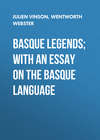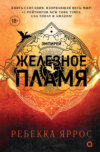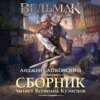Buch lesen: «Basque Legends; With an Essay on the Basque Language»
Introduction
The study of the recent science of Comparative Mythology is one of the most popular and attractive of minor scientific pursuits. It deals with a subject-matter which has interested most of us at one period of our lives, and turns the delight of our childhood into a charm and recreation for maturer age. Nor is it without more useful lessons. In it we see more clearly than perhaps elsewhere the reciprocal influence, which none can wholly escape, of words and language upon thought, and again of thought and fancy upon words and language; how mere words and syllables may modify both conception and belief; how the metaphor, which at first presented an object more clearly and vividly to the mind than any more direct form of speech could do, soon confuses and at last wholly distorts the original idea, and buries its meaning under a new and foreign superstructure. We may mark here, too, by numerous examples, how slowly the human mind rises to the conception of any abstract truth, and how continually it falls back upon the concrete fact which it is compelled to picture to itself in order to state in words the simplest mental abstraction. The phrase, “The dawn flies before the sun,” passing into the myth of Daphne and Apollo, is a lesson in psychology no less than in philology and in comparative mythology.
Now, both the interest and the value of these studies are enhanced in proportion as they become complete. Our conclusions approach nearer to certainty, and will gradually pass from theory to demonstration, as we find the same legends and modes of thought and expression on natural phenomena constantly reappearing among the most distant and the most isolated peoples, in languages which in their complex forms tell of the infancy of human speech, and also in those whose worn-down frame speaks of the world’s old age.
Of the peoples now settled in Western Europe, the Basques are those which are the most separate from other populations; distinct in language, they represent, in a more or less mixed state, some older stratum of European ethnology. Their language, too, as regards the mass of the people, is still practically unwritten.1 Here there is a chance of finding legends in a purer and older form than among any other European people; and in what they have borrowed from others, we may have an almost unique crucial test of the time which it takes for such traditions to pass orally from people of one language to another and totally different one. None of these legends have been published or even noticed till within the last two years, when M. d’Abbadie read the legend of the Tartaro before the Société des Sciences et des Arts de Bayonne, and M. Cerquand his “Légendes et Récits Populaires du Pays Basque,” before the sister society at Pau.2
Of course we must expect to find such legends very much altered, and in a state of almost inextricable confusion, and this not only through forgetfulness, and through the lapse of time since their origin, not only by the influence of a total change of religion, but they are also mingled and inter-penetrated with totally new ideas; the old and the new will be found side by side in striking and sometimes grotesque contrast. As in Campbell’s “Tales of the West Highlands,” personages of mythical antiquity go to kirk, and indulge in other decidedly post-Reformation practices, so in these Basque tales the reader must not be startled by the introduction of maize and tobacco, of cannon and gunpowder, of dances at the mairie, and the use of the guillotine, in stories which, perhaps, originally told of the movements of the stars, of the wars of the forces of the atmosphere, of the bright beauty of the rising, or of the glowing glory of the setting sun.3 The body is the same in all ages, but the dress varies with the changing fashions. To borrow an illustration from a slightly older science, this is not a simple case of contorted and overlying strata to be restored to their original order, but rather of strata worn down, reconstructed, and deposited anew, and even modified in their latest stage by the interference of human action. And thus our problem becomes an exceedingly complex and difficult one, and our readers must not be disappointed if our conclusions are not so clear and positive as might be wished. The present is merely a tentative, and not, in any sense, a final essay towards its solution.
How are these legends told now, and how have they been preserved? They are told by the Basque peasants, either when neighbours meet—after the fashion made familiar to us by American novelists in the “Husking Bee”—for the purpose of stripping the husks from the ears of maize, an operation generally performed in one or two long sessions; or at the prolonged wedding and other feasts, of which we have evidence in the tales themselves, or else in the long nights round the wintry hearth of their lonely dwellings. For it is one of the charms of the Basque land that the houses are scattered all over the face of the country, instead of being collected into crowded villages; and it is, perhaps, to this fact chiefly that we owe the preservation of so much old-world lore, and of primitive ideas, among this people. The reader must not be surprised at the length of some of our specimens. The details of the incidents of the longest are religiously preserved and, as told at home, they are probably more lengthy (as anyone will understand who has ever taken anything down from recitation) than as here given. Many an unlettered Basque peasant could serve an irritable stranger as Glendower did Hotspur, when he kept him “at least nine hours in reckoning up the several devils’ names that were his lackeys.”
In La Soule the “Pastorales,” or Basque dramas, which last from six to eight hours of uninterrupted action, are learnt in the same way by word of mouth during the long evenings of winter.
These legends are still most thoroughly believed in. They still form part of the faith of these simple people—not at all, we need hardly say, in the use of mythological or atmospheric allegory, but as narratives of veritable fact. They believe them as they do the histories of the Bible or the “Lives of the Saints.” In fact, the problem of reconciling religion and science presents itself to their minds in this strange guise—how to reconcile these narratives with those of the Bible and of the Church. The general solution is that they happened before the time of which the Bible speaks, or before Adam fell. They are “Lege zaharreko istorriguak”—“histories of the ancient law”—by which is apparently meant the time before Christianity. “This happened, sir, in the time when all animals and all things could speak,” was said again and again by our narrators at the commencement of their story; not one doubted the literal truth of what they told. Their naïve good faith occasionally severely tested our own gravity. Appeal was often made to our supposed superior knowledge to confirm the facts. The varying tone of the voice told how truly the speakers sympathised with what they uttered. At times sobs almost interrupted utterance, when the frequent apostrophe came: “Think how this poor so-and-so must have suffered!” More often bursts of laughter at traditional jokes, too poor to raise a smile on less unsophisticated lips, broke the recital. Very determined, too, is their adherence to what they believe to be the genuine text of these old tales. “I don’t understand it, but the history says so;” “It is so;” “The story says so,” was positively affirmed again and again—e.g., in one of the Peau d’Ane or Cinderella stories, when the lady has dazzled her admirer by her dress of silver (moonlight?), then of gold (sunlight?), then of diamonds (dew-drops?), at last, on the wedding-day, the bride and bridegroom dress each other. “I don’t know why,” interrupted the story-teller, “but the story says so.” Could anything tell more quaintly of the marriage of the sun and dawn? The sun decking the morning clouds with his light and beauty, and they again robing him in their soft and tender colouring.
But we must pass on to the tales themselves. None of these, we think, will be found to be genuinely or exclusively Basque; the oldest we take to be those most widely known, and which are most distorted. The heads under which we have arranged them are: (1) Legends of the Tartaro, or Cyclops; (2) of the Heren-Suge, the Seven-Headed Serpent; (3) of purely Animal Tales, which are neither fables nor allegories; (4) of Basa-Jauna, Basa-Andre, and of the Lamiñak, or Fairies; (5) Tales of Witchcraft; (6) those which, for want of a better name, we have entitled Contes des Fées, in which the fairy is an Eastern magician—these we have divided into sections, (a) those which resemble the Keltic and other tales, and (b) those which are probably borrowed directly from the French; our last division (7), Religious Tales and Legends, are probably from mediæval sources common to Latin Christianity, but they are interesting as specimens of the tales which probably delighted the highest born of our own ancestors in the middle ages, and now linger only among the peasantry in out-of-the-way corners of Europe. Some of these tales seem to us to be more gracefully told, and have more of human interest in them, than any of the others.
We fear scientific men will be disappointed in this collection. Notwithstanding that we have been careful to collect from those who know the Basque only, or who certainly knew only Basque when they first learnt these tales, yet they are evidently much mixed with French and Spanish. Our translations are literal to baldness; the only liberty we have taken is in softening down the exceeding directness and grossness of some portions. Not one tale is in the least licentious—but the Basque language calls a spade a spade, and not an implement of husbandry.4 The Carlist war of the last four years has prevented our getting any legends from the Spanish Basque provinces, and has even to some extent hindered our work in the French Pays Basque, by providing an almost exclusive object of interest. In the more remote districts of the Pays Basque itself, which we have not been able to revisit since we commenced this collection, purer forms of some of these legends may be found, and others of which we have no example;5 but these which we give are really representative. Though collected mainly in the neighbourhood of St. Jean de Luz, we have tested them by enquiry of natives of all the provinces, and find that they are equally well known in La Soule and in Basse Navarre as in the Labourd. We never met with a Basque peasant who could not tell us what are the Tartaro, the Heren-Suge, Basa-Jaun, and the Lamiñak.
As a curious coincidence, we may notice how closely some of the Basque names of the stars parallel those given in Miss Frere’s delightful “Old Deccan Days.” In the narrator’s narrative, pp. 27, 28, we read, “She (the grandmother) would show us the hen and chickens” (the Pleiades)—the same in Basque, “Oiloa chituekin;” “The three thieves climbing up to rob the Ranee’s silver bedstead”—the three stars in Orion’s belt, in Basque, the three kings, or brothers, or robbers; the milky way, “the great pathway of light on which He went up to heaven,” has also obtained in Basque a Christianized name—”Erromako zubia, or Bidea,” “the bridge or road to Rome.” Again, “All the cobras in my grandmother’s stories were seven-headed,” so the Heren-Suge in the Basque country is always seven-headed. Little or nothing can be gathered from the names of the actors, the heroes or heroines of these tales. They are mostly anonymous, but the name, when given, is almost always borrowed from the French. This is disappointing, and much increases the difficulty of tracing the origin; but it is analogous to the fact that scarcely a single purely Basque name is to be found among the so-called kings and chieftains of the Basques during the early middle ages.6 Among the classic writers, too, and among the soldiers and followers of our Anglo-Gascon princes, hardly a name indubitably Basque is to be found.
For all more special details and discussions we refer to the Introductions to the separate sections. The few references given to the parallel legends of other countries are not intended to be at all complete, much less exhaustive. The Pays Basque is not a land of libraries, and it is not easy to collect these legends on the spot, and at the same time to get together the books necessary for a comparison of them with those of other countries. The few we offer are only those which have fallen in our way, and though worthless to the specialist, may be of some little aid as suggestions to the ordinary reader.7 For the same purpose we annex a list of the first publication of the chief collections of foreign legends in France.8 It is curious to remark that, while the masterpieces of French literature seem never to have penetrated beyond the surface of society, these legends have pierced to the very bottom of the social mass, and have become real living household words, even to those many millions of Frenchmen who do not understand one word of French.
There remains the pleasant task of thanking some of the many friends who have assisted us in this collection. I had hoped to have joined the name of M. J. Vinson, the well-known Basque and Dravidian scholar, to my own as joint-author of this simple work. I should hardly have had the courage to have undertaken it had I not been assured of his invaluable assistance in difficulties about the language of the originals. Unavoidable circumstances have, however, prevented his seeing the Basque of many of the later tales, and he therefore prefers that the “Essay on the Basque Language” should alone bear his name. I cannot but accede to his wishes; but, at the same time, I offer him my most grateful thanks for the unfailing and unwearied help which he so kindly afforded me for many months. The legends contributed by him are noticed in their proper place. Our first acknowledgments are due to M. d’Abbadie, of Abbadia, the well-known “Membre de l’Institut,” for his kind assistance and ready communication of the legends in his possession, and which were the starting point of our work. Next, and even more, to Madame M. Bellevue, of Dajieu-baita, through whose kind intervention the majority of these tales were collected, and who assisted in the translation of almost all. And then to the sisters Estefanella and Gagna-haurra Hirigaray, who contributed more than twenty tales; to Dr. Guilbeau and other friends at St. Jean de Luz who have taken a friendly interest in our work, and to all those whose names are appended to the tales they furnished. It would be presumptuous to hope that our readers will find as much pleasure in perusing these tales as we have had in collecting them.
I.—Legends of the Tartaro
Who, or what is the Tartaro? “Oh! you mean the man with one eye in the middle of his forehead,” is the prompt and universal answer. The Tartaro is the Cyclops, the sun’s round eye, κύκλωψ. But the word Tartaro has apparently nothing to do with this. M. Cerquand, in his “Legendes et Récits Populaires du Pays Basque,” derives the word from Tartare, Tartar, in the same way as the French word Ogre is said to be derived from Hongrois, Ugri. The only objection to this highly probable derivation (made still more probable by a Souletin variation, Moiriak) is the comparatively late date (the 13th century) of the first appearance of the Tartars in Europe.9 It is besides perfectly true that in many tales the Tartaro replaces, and is identical with the giant or ogre; but this does not appear to us to be the original conception of this mythological monster, nor have we ever heard from an unlettered Basque such a description of him. To them he is simply a Cyclops—a huge man, with an eye in the centre of his forehead.
It is an interesting question—Is there any connection between the Basque Tartaro and the Cyclops of the Odyssey and of the classics? First, we must remark that the Cyclops legend is not peculiar either to the Greek and Latin writers, or even to the Aryan nations; e.g., in his communication of the Tartaro legends to the Société des Sciences de Bayonne, M. d’Abaddie relates how he heard the tale told in June, 1843, in Eastern Africa, in Lat. N. 9.2, E. Lon. 34.48, by a man who had never before quitted the country. It is then only the special form of the legend, and not the primary idea, that the Greeks may have borrowed from the Basques. But there is this to observe—that, with both Greeks and Latins, the Cyclops myth is an occidental and not an oriental one, and is more strictly localised than almost any other. This may be accounted for by saying that the sun’s great fiery eye is rather that of the setting than of the rising sun; that the red-hot stake is the ruddy mountain peak, or the tall fir-trunk, seen against the western horizon, and illumined by his descending rays. But in the stories of Theocritus and Ovid, where the sun-myth is not so apparent, the home of the Cyclops is still Sicily. Our first Tartaro legend reads very like a rough outline of Ovid’s story of “Acis and Galatea.” Now, W. Von Humboldt in his “Prüfung der Untersuchung über die Urbewohner Hispaniens vermittelst der Vaskischen Sprache” (Berlin, 1821), in cap. xlv., p. 167, and, again, con. vii., p. 178, arguing on quite different grounds, places Sicily as the most easterly habitation of the Basques within historic times.10 We leave it then to classical scholars to consider whether the Italic races in Magna Græcia and Sicily may not have come in contact with the Basques there, and from them have adopted their special form of the Cyclops legend.
As we said above, the Tartaro sometimes replaces the giant or the ogre; at other times we find him as Basa-Jaun, or even as an animal, substituted for Acheria, the fox. He is, in his proper form, a huge one-eyed giant, occasionally a cannibal, but not without a rough “bonhomie” when satiated with food and drink. Intellectually far below the feebler race of mankind, he is invariably beaten in his contests with them, notwithstanding his enormous strength; he loses all his wagers, and is generally lured on to commit involuntary suicide. In some aspects he reminds one of Milton’s “Lubbar Fiend,” and in his constant defeats and being constantly outwitted, recals one of the types of the Devil in mediæval story. At times he appears in gentler guise, as when he aids the young prince to his rights, and supplies Petit Yorge with the means of victory over the Heren-Suge. What the talking ring is which appears in so many of these stories we confess ourselves unable to interpret; it is found in the Keltic, but, as far as we are aware, not in the classic legends.
One peculiarity of the Basque, and especially of the Tartaro legends, is that the hero of them is so often a madman, an idiot, or a fool. If we can trust our memory, the case is the same in the Slavonic representatives of Odysseus.11 But the Basques seem to dwell upon and to repeat the idea in a peculiar way; they ring the changes on all states, from the wild madman, like the Scandinavian Berserker, through the idiot and fool, to the mere blockhead and ninny. Errua, Enuchenta, Ergela, Sosua, Tontua, are terms employed to designate the heroes who have sometimes, to our modern apprehension, little of the idiot or fool, except the name. Can it be that the power which put out the sun’s fiery eye was looked upon as a beneficent being in a burning tropic land, while, as the legend travelled northward, the act seemed more like that of madness, or of senseless stupidity?
One type of these Tartaro tales will at once recal Grimm’s “Valiant Little Tailor,” and some of the more modern versions of “Jack the Giant-Killer.” But though the incidents are identical, it is hardly possible that they can be thus borrowed. Several of our narrators were utterly ignorant of French, and learnt the tale as children from old people, who died a few years since at upwards of 80. The first translation of Grimm’s Tales into French was published in the year 1845.










